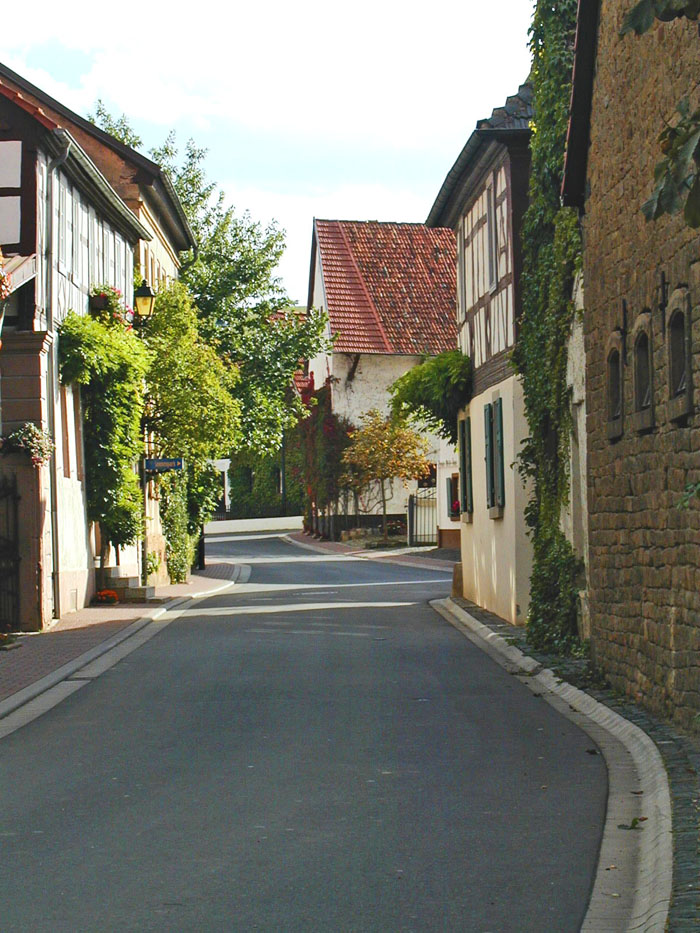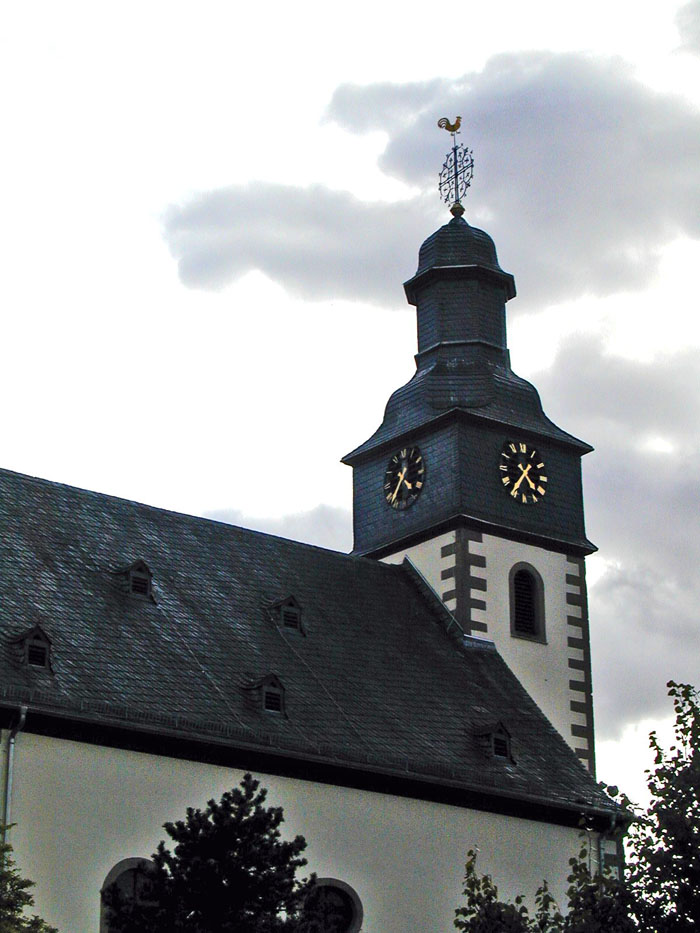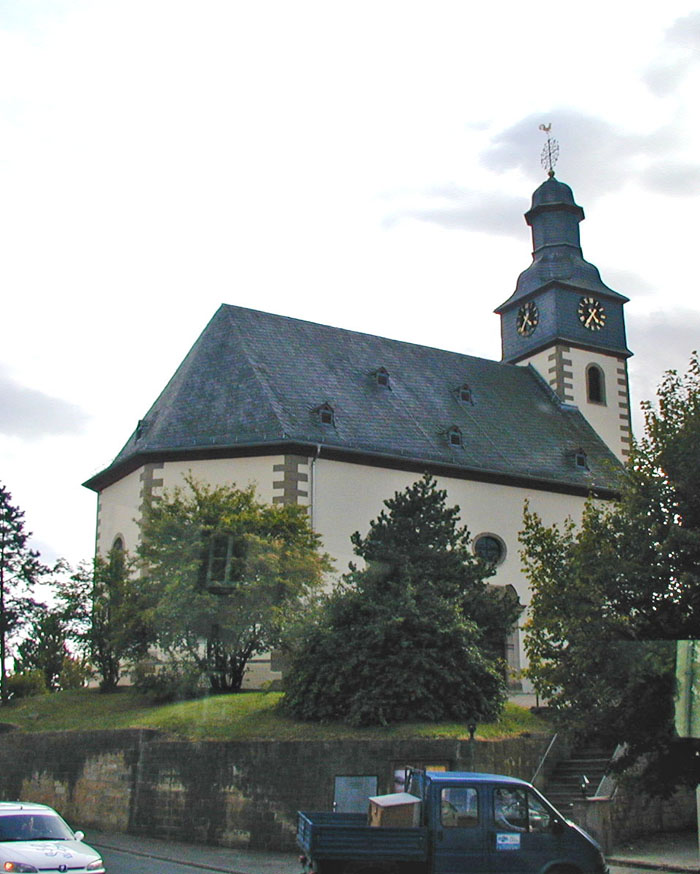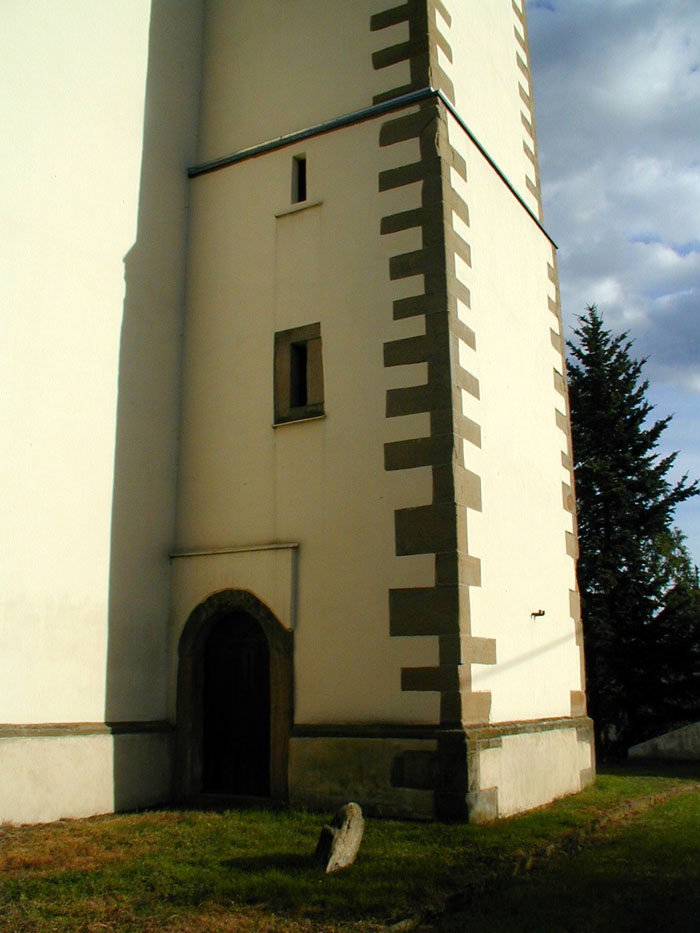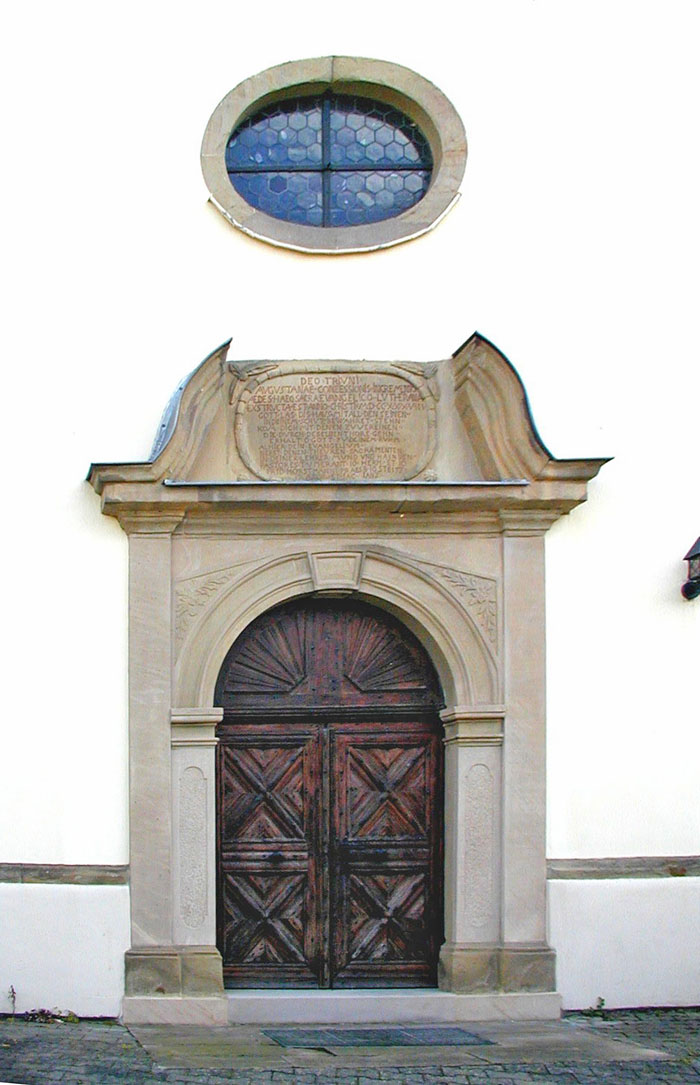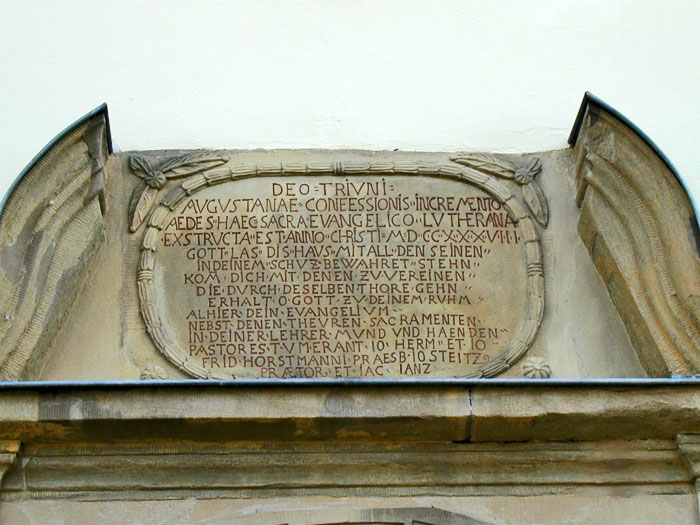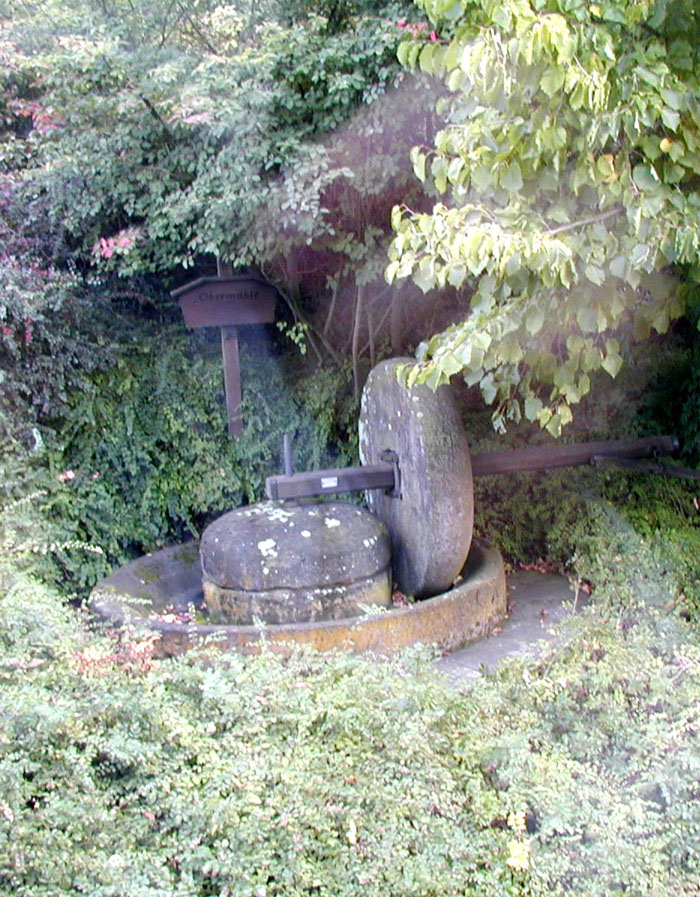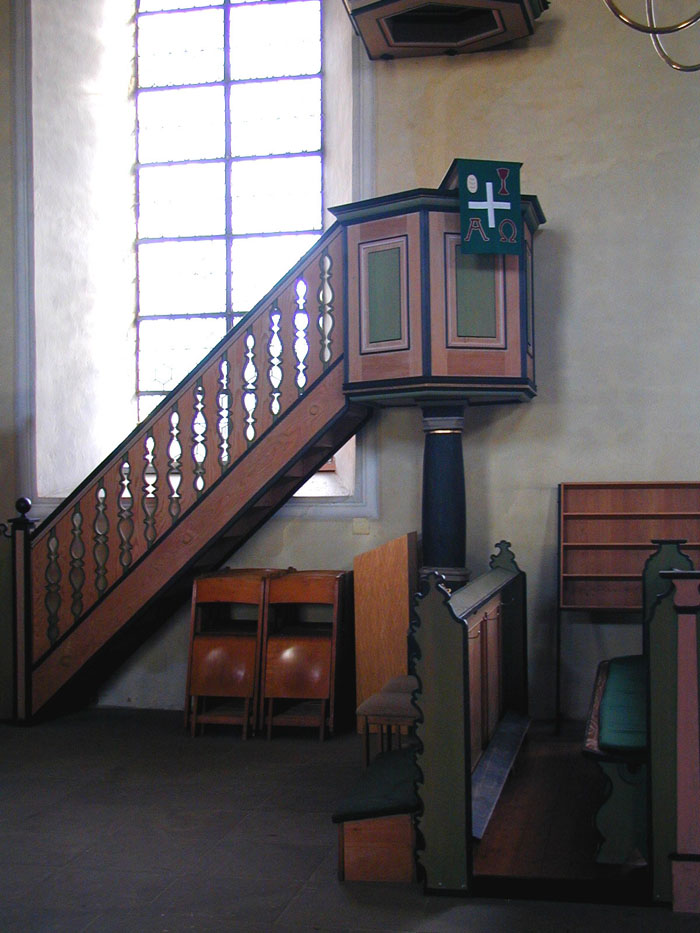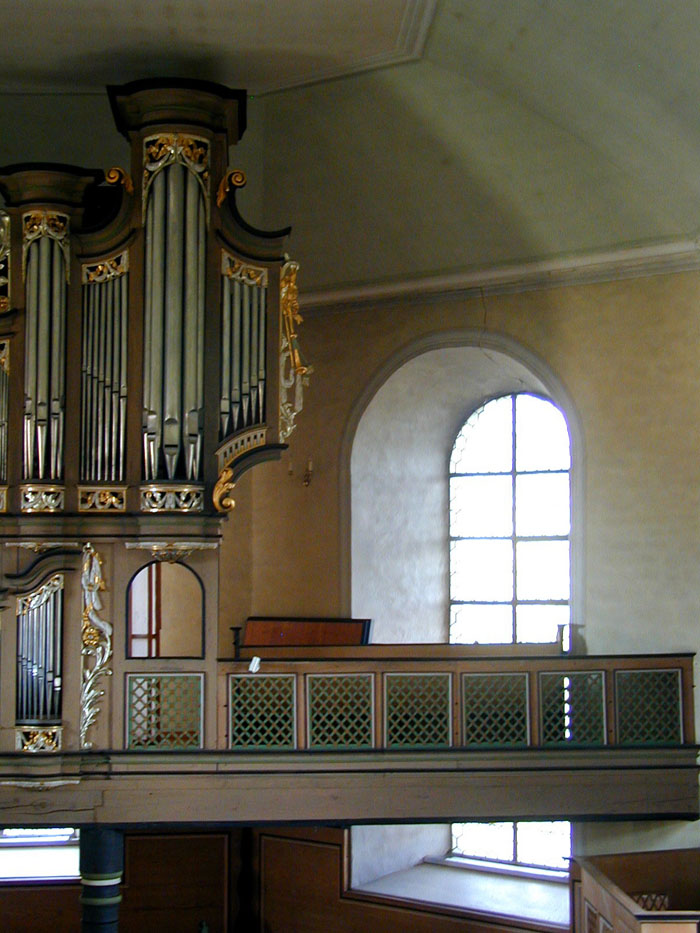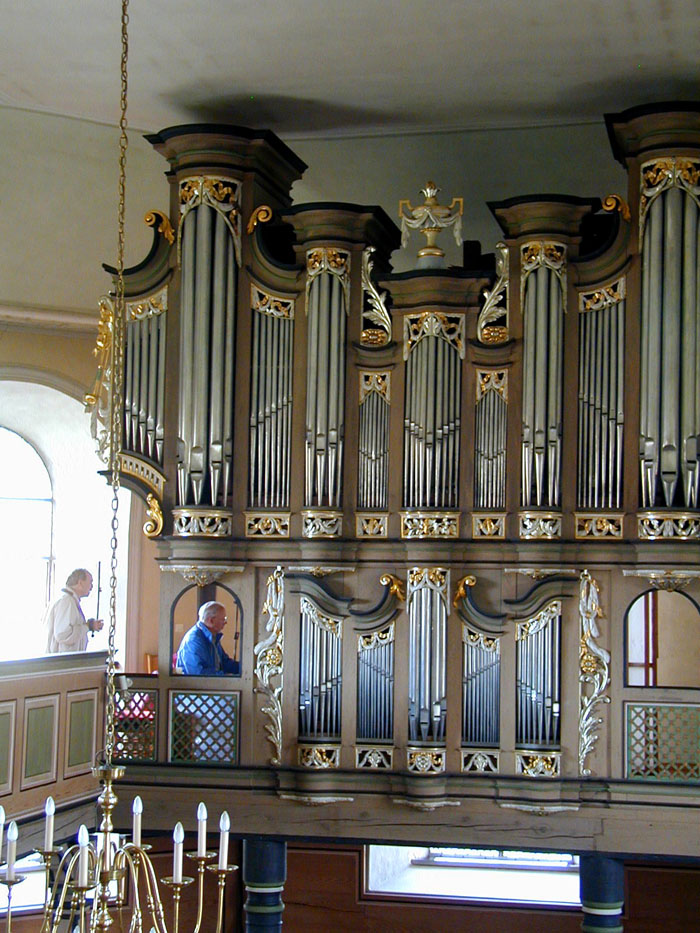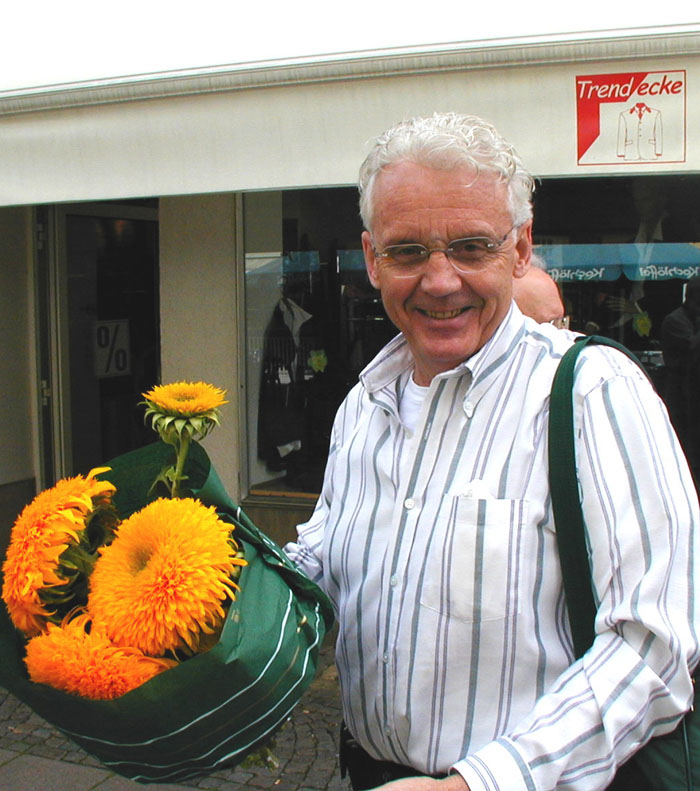The Christlieb-Chrislip-Crislip Family Association Archives
Here, will be kept various presentations and other archival materials pertaining to the Christlieb-Chrislip-Crislip Family Association.
Our Pre-American History — Towns and Villages in the German Rhineland
Pertinent
to Our Immigrant Ancestors
— Dielkirchen —
Communities of the Engel Family
Following the Death of Anna Catharina's Father,
Johann Peter Engel
1668–1718
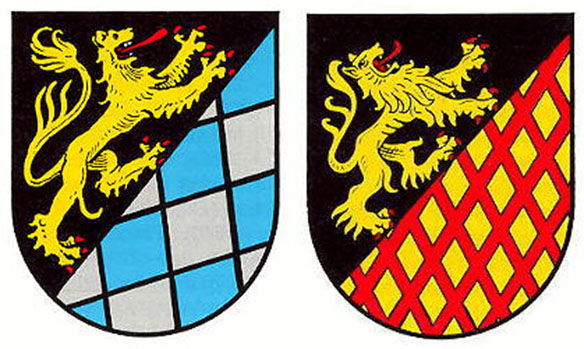
Crests for the Town of Dielkirchen
Elements of which have been combined into ours.
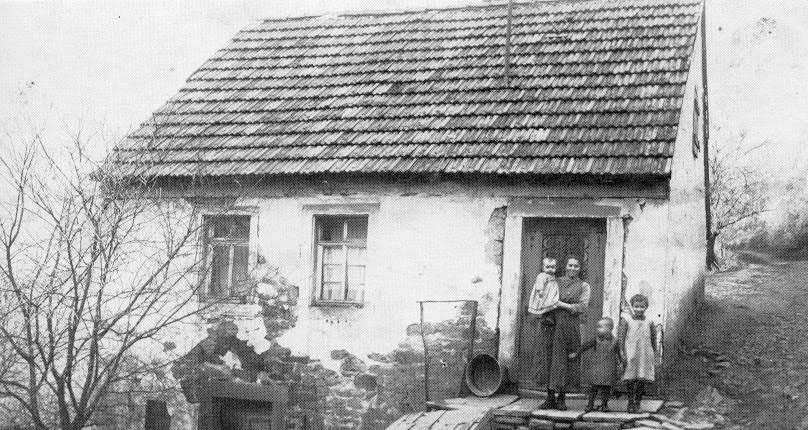
Dating from the early years of the 18th century, this is Dielkirchen's oldest house.
Anna Catharina's background is more detailed than Friedrich Carl's. The church registers of St. Alban and Dielkirchen reveal the names of her parents and her siblings, as well as the communities where they lived.
The daughter of Johann Peter and Anna Gerdrauth Engel, Anna Catharina was born ca. 1710 (between the years 1707 and 1711) in the tiny community of Gerbach. Because there was no Lutheran church in Gerbach, the Engel family worshipped at St. Alban, another small community within easy walking distance of Gerbach. Because of their close proximity to one another and strong indications that the Engels resided in both villages throughout the years, the appellation, St. Alban-Gerbach appears both in church registers and in this report. Situated about a quarter mile apart, St. Alban and Gerbach are located some 30 miles northwest of Dürkheim.
Anna Catharina, the future mother of Jacob and Carl Christlieb, married Gottfried [Gottfrid] Bock at Dielkirchen on April 17, 1736. Born in 1712, the groom was 24 years of age. Although Anna Catharina could have been born as early as 1707, it is doubtful that she would have been five years her husband’s senior. If that were the case, she would have been ages 42 and 44 respectively, when Jacob and Carl were born. It is more reasonable to believe that Anna Catharina’s birth occurred ca. 1710.
The fates of Anna Catharina’s mother, brother and sisters are completely unknown. None appear in the death records at Dielkirchen or in the church records of surrounding communities. Like their sister, Anna Catharina, they seem to have vanished from the area. Perhaps their lives followed courses similar to Anna Catharina, who married, moved to a distant community, and then to America.
Anna Catharina's Marriage to Gottfried Bock
Gottfried Bock and Anna Catharina’s marriage appears to have been a double wedding with Adam Heddesheim and Catharina Mertz. Both grooms are believed to have resided at Cölln where they are believed to have been employed at the silver-quicksilver mines at Stahlberg.
Because Mannweiler-Cölln belonged to the Lutheran parish of Dielkirchen, the marriages took place there. Shown here is the original combined marriage entry for the two couples:
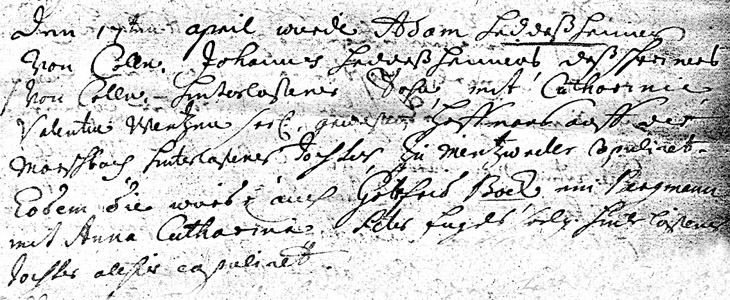
Translated, the combined entry reads:
“On 17th April, Adam Heddesheimer of Cölln, surviving son of Johannes Heddesheimer, the joiner of Cölln, was married to Catharina, surviving daughter of Valentine Mertz, the late former farm administrator on the Morsbacherhof farm, at Mannweiler [Mayntzweiler]. On the same day, [April 17, 1736], Gottfrid Bock, a miner, was married to Anna Catharina, surviving daughter here of the late Peter Engels.”
Dielkirchen Churches
The first written record of the village of Dielkirchen dates from 872 A.D. During the Protestant Reformation, Dielkirchen became a Protestant village (ca. 1544), but Catholics also lived there and were allowed, by decree, to worship in the same building as the Protestants.
At least two churches preceded the present-day church at Dielkirchen. The first known building was destroyed during the Thirty-Years’ War (1618-1648). Shown here is a preserved fragment from that building:
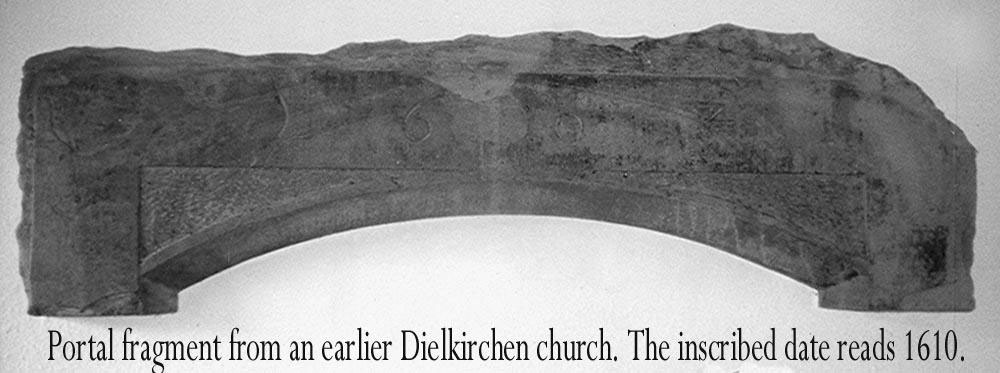
Around 1656, the Lutheran congregation built a replacement church with whatever materials they could find in those post-war days. Built as a temporary structure until something more substantial could be built, the building stood for about 80 years, until being torn down in 1738. Married on April 17, 1736, Anna Catharina Engel and Gottfried Bock were probably married in this church.
Although it is known that their son, Johann Georg Bock, was born in 1737, there is no baptismal record for him at Dielkirchen that year, an indication that the family had left the area. Nothing further is known about Georg and Anna Catharina Bock’s whereabouts until about three years later, when their daughter, Johanna Susanna Elizabetha, was baptized at Dürkheim in 1740.
Two clergymen, Johann Hermann Horstmann and his son, Johann Friedrich Horstmann, were pastors at Dielkirchen. Johann Hermann Horstmann, who was pastor from 1697-1740, would have officiated at the marriages of Anna Gerdrauth (Anna Catharina’s mother) and Anna Barbara (Anna Catharina’s sister). Johann Friedrich Horstmann joined his father as adjunct pastor in 1728 and remained pastor of the Dielkirchen church until 1748. Either of the men could have officiated at the marriage of Anna Catharina or that of her brother, Andreas.
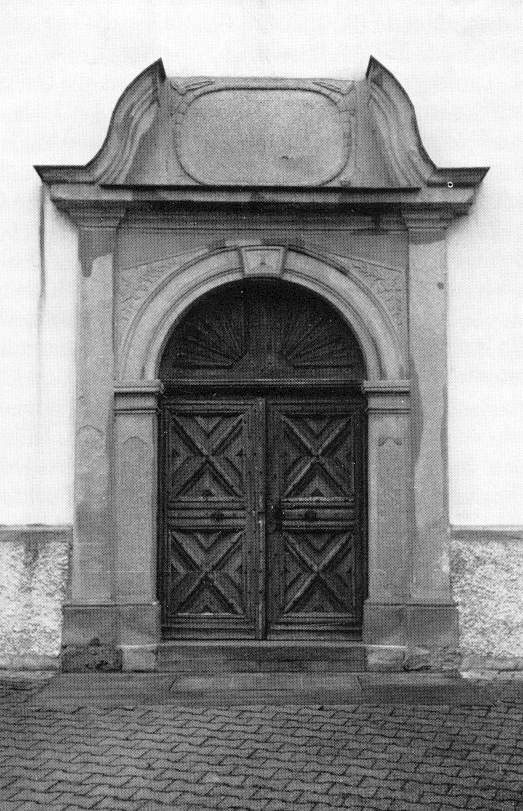
Written in both Latin and German, the inscription over the
main door of the Dielkirchen Church reads:
“For
the triune God and for the faithful of the Augsburg Diocese, this Evangelical-Lutheran holy place is built
in the Year of Christ 1738. God, keep this house and all of your faithful safe in your protection. Come to unite
yourself with your people, who pass through these doors. Preserve here, O Lord in your glory your Gospel
and your precious sacraments through the mouths and hands of your teachers.”
Written in the church’s history is that fact that the old church was not torn down until the new one was completed in 1738. Because the congregation was active in building the new church, it is probable that Anna Catharina and her family were involved in its construction. The building materials were reportedly paid for by the congregation, which the farmers offered to transport for free. The neighboring villagers helped with the building of the church by volunteering the services of their horse teams.
As already mentioned, the new edifice was completed around 1738. According to Dielkirchen’s history “...while the old church was still standing and the new one was yet to be completed, the Catholics of the region requested [through permission of the State] that they be allowed to share the building with the Lutherans without having any claim to it. This was agreed upon in order to assure that the minority Catholics had a house of worship.”
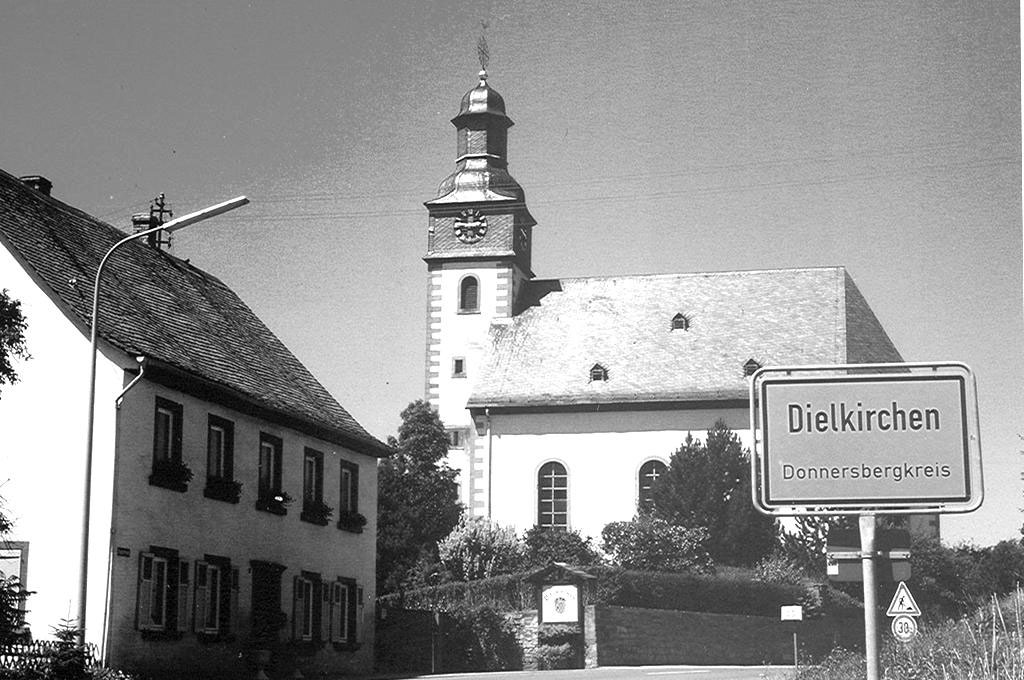
The new Lutheran Church at Dielkirchen, erected while Anna Catharina and her husband, Gottfried Bock,
were residents of the community.
The construction of the new church was underway when Anna Catharina Engel and Gottfried Bock were married at Dielkirchen on April 17, 1736. Permission given to Catholics to worship in the new church shows religious sufferance as a positive outcome of the Thirty-Years’ War.
When the church was razed, four ancient stone burial crypts were unearthed. These were accompanied by stone figures, part male and part female, stemming from the same time period and found next to a stone pot for sacred water. One figure, as well as a piece of roof tile, dated from Roman times. Although some concluded that the stone coffins dated from the 11th or 12th centuries, historians at the Pfalz Museum theorized that all of the artifacts dated from Roman times. Information and photos are from a 1962 booklet printed on the occasion of the 50th Anniversary of the new church at St. Alban.
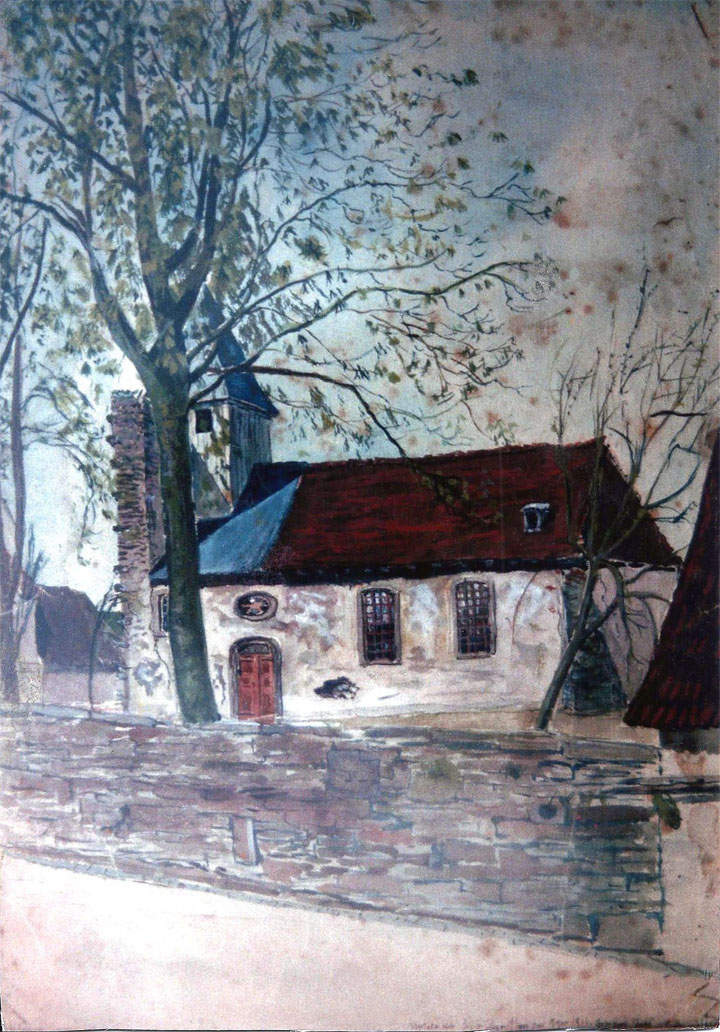
A rendering of the second church at St. Alban (1648-1912), painted by a woman who grew up in its presence. This was the family church of Jacob and Carl's mother's family. Remnants of the original stone spire can be seen in front of the later-constructed wooden steeple.

“November 18, 1737. Andreas Engel, son of the late Peter Engel, was married to Catharina, Daughter of Peter Mertz.”
Although there are no baptismal records for Peter and Anna Gerdraudt Engel’s children at St. Alban, they do appear in confirmation records, some of which had been copied from earlier records.
Anna Catharina’s sister, Elizabetha, appears among a list of boys and girls who were confirmed at St. Alban in 1714, the year that the new church register was created. Using age fourteen as the customary age for confirmation, it can be assumed that Anna Elizabetha was born in 1700. Anna Catharina and Anna Barbara’s names appear on a list of persons confirmed between the years 1721 and 1748. Again, using fourteen as the age for confirmation, a child confirmed as early as 1721 would have been born in 1707, while any of those on the list who were confirmed as late as 1748 would have been born in 1713. Had any of Anna Catharina’s siblings been born in 1714 or later, their names would have appeared in the new church book’s baptismal register.
The above leads one to conclude that the known children of Johann Peter and Anna Gerdrauth were born in the first decade of the 18th century or very shortly thereafter.
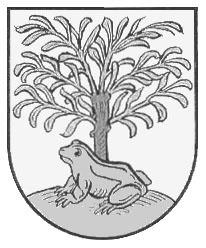
Johann Peter Engel's family would have been familiar with this ancient shield (Wappen) shared by the communities of St. Alban and Gerbach. The significance of the frog and tree are unknown.
Anna Catharina, the future mother of Jacob and Carl Christlieb, married Gottfried [Gottfrid] Bock at Dielkirchen on April 17, 1736. Born in 1712, the groom was 24 years of age. Although Anna Catharina could have been born as early as 1707, it is doubtful that she would have been five years her husband’s senior. If that were the case, she would have been ages 42 and 44 respectively, when Jacob and Carl were born. It is more reasonable to believe that Anna Catharina’s birth occurred ca. 1710.
The fates of Anna Catharina’s mother, brother and sisters are completely unknown. None appear in the death records at Dielkirchen or in the church records of surrounding communities. Like their sister, Anna Catharina, they seem to have vanished from the area. Perhaps their lives followed courses similar to Anna Catharina, who married, moved to a distant community, and then to America.
Anna Catharina’s Marriage to Gottfried Bock
Gottfried Bock and Anna Catharina’s marriage appears to have been a double wedding with Adam Heddesheim and Catharina Mertz. Both grooms are believed to have resided at Cölln where they are believed to have been employed at the silver-quicksilver mines at Stahlberg.
Because Mannweiler-Cölln belonged to the Lutheran parish of Dielkirchen, the marriages took place there. Shown here is the original combined marriage entry for the two couples.

In modern German, the Bock portion of the double entry reads:
“Eodem die wurde auch Gottfrid Bock ein Bergman mit Anna Catharina, Peter Engels seelig, hinterlabener Dochter all heir copoliret.”
Translated, the combined entry reads:
“On 17th April, Adam Heddesheimer of Cölln, surviving son of Johannes Heddesheimer, the joiner of Cölln, was married to Catharina, surviving daughter of Valentine Mertz, the late former farm administrator on the Morsbacherhof farm, at Mannweiler [Mayntzweiler]. On the same day [April 17, 1736], Gottfrid Bock, a miner, was married to Anna Catharina, surviving daughter here of the late Peter Engels.”
Selected views of the Church at Dielkirchen.

